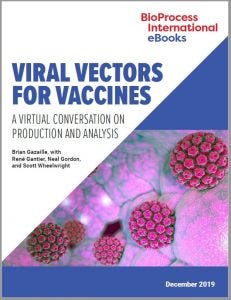Voices of Biotech
Podcast: MilliporeSigma says education vital to creating unbreakable chain for sustainability
MilliporeSigma discusses the importance of people, education, and the benefits of embracing discomfort to bolster sustainability efforts.
 Although today’s vaccines are safer, more effective, and more accessible than they were even 20 years ago, the emergence of new, complex pathogens has exposed limitations in traditional vaccine strategies. Viral vector vaccines (VVVs) hold great promise for confronting those now-intractable pathogens. Combining the best features of live-attenuated and DNA-vaccine approaches, these next-generation prophylactics seek to harness the infectivity of non- or low-immunogenicity viruses to shuttle antigen-encoding DNA from target pathogens into host cells. The resulting transduced cells then initiate the critical cell-mediated immune responses that conventional vaccines cannot induce. Researchers expect that the vector-vaccine strategy will have a big payoff, but the terrain is largely unknown, and drug companies and biomanufacturers still need to learn much about the modality to prepare vaccine operations for commercial scales.
Although today’s vaccines are safer, more effective, and more accessible than they were even 20 years ago, the emergence of new, complex pathogens has exposed limitations in traditional vaccine strategies. Viral vector vaccines (VVVs) hold great promise for confronting those now-intractable pathogens. Combining the best features of live-attenuated and DNA-vaccine approaches, these next-generation prophylactics seek to harness the infectivity of non- or low-immunogenicity viruses to shuttle antigen-encoding DNA from target pathogens into host cells. The resulting transduced cells then initiate the critical cell-mediated immune responses that conventional vaccines cannot induce. Researchers expect that the vector-vaccine strategy will have a big payoff, but the terrain is largely unknown, and drug companies and biomanufacturers still need to learn much about the modality to prepare vaccine operations for commercial scales.
This BPI eBook uses a “virtual roundtable” discussion among three industry experts — René Gantier (Pall Biotech, USA), Neal Gordon (BioProcess Technology Consultants, BDO USA), and Scott Wheelwright (Complya Asia) — to elaborate the challenges of manufacturing viral vector vaccines. Read on to learn more about the projected advantages of VVVs over more conventional approaches as well as key differences between vector production for vaccines and gene therapies, strategies for managing difficulties with quantifying and purifying virus particles, and ways that contract development and manufacturing organizations (CDMOs) can support drug sponsors during the transition from clinical trials to commercial-scale manufacture.
You May Also Like